Effects of Manure-Based Nitrogen Substitution for Chemical Nitrogen Fertilizers on Economic Benefits and Water-Use Efficiency of Maize
Abstract
:1. Introduction
2. Materials and Methods
2.1. Site Description and Experimental Design
2.2. Sampling and Analysis Methods
2.3. Statistical Analysis
3. Results
3.1. Soil Water Storage
3.2. Evapotranspiration
3.3. Maize Yield
3.4. Water Use Efficiency
3.5. Economic Benefit
3.6. Comprehensive Evaluation
4. Discussion
5. Conclusions
Supplementary Materials
Author Contributions
Funding
Data Availability Statement
Acknowledgments
Conflicts of Interest
References
- Jiang, G.; Zhang, W.; Xu, M.; Yakov, K.; Zhang, X.B.; Wang, J.Z.; Di, J.Y.; Daniel, V.M. Manure and Mineral Fertilizer Effects on Crop Yield and Soil Carbon Sequestration: A Meta-Analysis and Modeling Across China. Glob. Biogeochem. Cycles 2018, 32, 1659–1672. [Google Scholar] [CrossRef]
- Van Wesenbeeck, C.F.A.; Keyzer, M.A.; Van Veen, W.C.M.; Qiu, H. Can China’s overuse of fertilizer be reduced without threatening food security and farm incomes? Agric. Syst. 2021, 190, 103093. [Google Scholar] [CrossRef]
- Zhang, H.Y.; Erik, A.H.; Feng, P.Y.; Zhou, Z.X.; Niu, L.A.; Duan, W.K.; Hao, J.M.; Hu, K.L. Responses of soil organic carbon and crop yields to 33-year mineral fertilizer and straw additions under different tillage systems. Soil. Tillage Res. 2021, 209, 104943. [Google Scholar] [CrossRef]
- Worou, O.N.; Gaiser, T.; Saito, K.; Goldbach, H.; Ewert, F. Simulation of soil water dynamics and rice crop growth as affected by bunding and fertilizer application in inland valley systems of West Africa. Agric. Ecosyst. Environ. 2012, 162, 24–35. [Google Scholar] [CrossRef]
- Ibrahim, M.; Yamin, M.; Sarwar, G.; Anayat, A.; Habib, F.; Ullah, S.; Saif-ur-Rehman. Tillage and farm manure affect root growth and nutrient uptake of wheat and rice under semi-arid conditions. Appl. Geochem. 2011, 26, S194–S197. [Google Scholar] [CrossRef]
- Adekiya, A.O.; Ejue, W.S.; Olayanju, A.; Dunsin, O.; Aboyeji, C.M.; Aremu, C.; Adegbite, K.; Akinpelu, O. Different organic manure sources and NPK fertilizer on soil chemical properties, growth, yield and quality of okra. Sci. Rep. 2020, 10, 173–179. [Google Scholar] [CrossRef]
- Hati, K.M.; Swarup, A.; Mishra, B.; Manna, M.C.; Wanjari, R.H.; Mandal, K.G.; Misra, A.K. Impact of long-term application of fertilizer, manure and lime under intensive cropping on physical properties and organic carbon content of an Alfisol. Geoderma 2008, 148, 173–179. [Google Scholar] [CrossRef]
- Ibrahim, A.; Abaidoo, R.C.; Fatondji, D.; Opoku, A. Hill placement of manure and fertilizer micro-dosing improves yield and water use efficiency in the Sahelian low input millet-based cropping system. Field Crops Res. 2015, 180, 29–36. [Google Scholar] [CrossRef]
- Chen, S.; Zhang, X.; Shao, L.; Sun, H.; Niu, J.; Liu, X. Effects of straw and manure management on soil and crop performance in North China Plain. Catena 2020, 187, 104359. [Google Scholar] [CrossRef]
- Mannaa, M.C.; Swarupb, A.; Wanjaria, R.H.; Ravankarc, H.N.; Mishrad, B.; Sahae, M.N.; Singha, Y.V.; Sahid, D.K.; Sarapc, P.A. Long-term effect of fertilizer and manure application on soil organic carbon storage, soil quality and yield sustainability under sub-humid and semi-arid tropical India. Field Crops Res. 2005, 93, 264–280. [Google Scholar] [CrossRef]
- Liu, P.Z.; Lin, Y.R.; Liu, X.T.; Deng, M.Z.; Zhang, P.F.; Ren, X.L.; Chen, X.L. Manure substitution with appropriate N rate enhanced the soil quality, crop productivity and net ecosystem economic benefit: A sustainable rainfed wheat practice. Field Crops Res. 2023, 304, 109164. [Google Scholar] [CrossRef]
- Munyahali, W.; Birindwa, D.; Pypers, P.; Swennen, R.; Vanlauwe, B.; Merckx, R. Increased cassava growth and yields through improved variety use and fertilizer application in the highlands of South Kivu, Democratic Republic of Congo. Field Crops Res. 2023, 302, 109056. [Google Scholar] [CrossRef]
- Yost, J.L.; Leytem, A.B.; Bjorneberg, D.L.; Dungan, R.S.; Schott, L.R. The use of winter forage crops and dairy manure to improve soil water storage in continuous corn in Southern Idaho. Agric. Water Manag. 2023, 277, 108074. [Google Scholar] [CrossRef]
- Ren, X.L.; Jia, Z.K.; Chen, X.L.; Han, Q.F.; Han, J. Effect of Corn (Zea mays L.) Water and Temperature of Ridge and Furrow Planting of Rainfall Harvesting Under Simulated Rainfall Conditions. Sci. Agric. Sin. 2008, 41, 70–77. [Google Scholar]
- Robertson, G.P.; David, C.C.B.; Caroline, S.B.; Philip, S. Standard Soil Methods for Long-Term Ecological Research; Oxford University Press: New York, NY, USA, 1999. [Google Scholar]
- Liang, J.P.; He, Z.J.; Shi, W.J. Cotton/mung bean intercropping improves crop productivity, water use efficiency, nitrogen uptake, and economic benefits in the arid area of Northwest China. Agric. Water Manag. 2020, 240, 106277. [Google Scholar] [CrossRef]
- Zhang, S.L.; Lövdahl, L.; Grip, H.; Jansson, P.; Tong, Y.A. Modelling the effects of mulching and fallow cropping on water balance in the Chinese Loess Plateau. Soil. Tillage Res. 2007, 93, 283–298. [Google Scholar] [CrossRef]
- Payero, J.O.; Tarkalson, D.D.; Irmak, S.; Davison, D.; Petersen, J.L. Effect of irrigation amounts applied with subsurface drip irrigation on corn evapotranspiration, yield, water use efficiency, and dry matter production in a semiarid climate. Agric. Water Manag. 2008, 95, 895–908. [Google Scholar] [CrossRef]
- Duncan, D. Multiple range and multiple F tests. Biometrics 1955, 11, 1–42. [Google Scholar] [CrossRef]
- Sonsri, K.; Watanabe, A. Insights into the formation and stability of soil aggregates in relation to the structural proper-ties of dissolved organic matter from various organic amendments. Soil. Tillage Res. 2023, 232, 105774. [Google Scholar] [CrossRef]
- Duan, C.X.; Li, J.B.; Zhang, B.B.; Wu, S.F.; Fan, J.L.; Feng, H.; He, J.Q.; Kadambot, H.M. Siddique c Effect of bio-organic fertilizer derived from agricultural waste resources on soil proper-ties and winter wheat (Triticum aestivum L.) yield in semi-humid drought-prone regions. Agric. Water Manag. 2023, 289, 108539. [Google Scholar] [CrossRef]
- Udom, B.E.; Udom, G.J.; Otta, J.T. Breakdown of dry aggregates by water drops after applications of poultry manure and spent mushroom wastes. Soil. Tillage Res. 2022, 217, 105267. [Google Scholar] [CrossRef]
- Liu, C.A.; Li, F.R.; Zhou, L.M.; Zhang, R.H.; Jia, Y.; Lin, S.L.; Wang, L.J.; Kadambot, H.M.S.; Li, F.M. Effect of organic manure and fertilizer on soil water and crop yields in newly-built terraces with loess soils in a semi-arid environment. Agric. Water Manag. 2013, 117, 123–132. [Google Scholar] [CrossRef]
- Liu, Y.; Miao, H.T.; Chang, X.; Wu, G.L. Higher species diversity improves soil water infiltration capacity by increasing soil organic matter content in semiarid grasslands. Land Degrad. Dev. 2019, 30, 1599–1606. [Google Scholar] [CrossRef]
- Tang, H.M.; Chao, L.; Xiao, X.P.; Pan, X.C.; Cheng, K.K.; Shi, L.H.; Li, W.Y.; Wen, L.; Wang, K. Effects of long-term fertiliser regime on soil organic carbon and its labile fractions under double cropping rice system of southern China. Acta Agric. Scandinavica. Sect. B Soil Plant Sci. 2020, 70, 409–418. [Google Scholar] [CrossRef]
- Meng, W.; Sun, X.H.; Ma, J.J.; Guo, X.H.; Zheng, L.J. Evaporation and Soil Surface Resistance of the Water Storage Pit Irrigation Trees in the Loess Plateau. Water 2019, 11, 648. [Google Scholar] [CrossRef]
- Revilla, P.; Alves, M.L.; Andelković, V.; Balconi, C.; Dinis, I.; Mendes-Moreira, P.; Redaelli, R.; de Galarreta, J.I.R.; Vaz Patto, M.C.; Žilić, S.; et al. Traditional Foods from Maize (Zea mays L.) in Europe. Front. Nutr. 2022, 8, 683399. [Google Scholar] [CrossRef]
- Xiang, Y.Z.; Li, Y.; Luo, X.Q.; Liu, Y.; Yue, X.J.; Yao, B.; Xue, J.M.; Zhang, L.Y.; Fan, J.; Xu, X.Y.; et al. Manure properties, soil conditions and managerial factors regulate greenhouse vegetable yield with organic fertilizer application across China. Front. Plant Sci. 2022, 13, 1009631. [Google Scholar] [CrossRef]
- Vasbieva, M.T. Effect of Long-Term Application of Organic and Mineral Fertilizers on the Organic Carbon Content and Nitrogen Regime of Soddy-Podzolic Soil. Eurasian Soil. Sci. 2019, 52, 1422–1428. [Google Scholar] [CrossRef]
- Zhang, Z.Y.; Dong, X.X.; Wang, S.M.; Pu, X.Z. Benefits of organic manure combined with biochar amendments to cotton root growth and yield under continuous cropping systems in Xinjiang, China. Sci. Rep. 2020, 10, 4718. [Google Scholar] [CrossRef]
- Zhang, Y.L.; Li, C.H.; Wang, Y.W.; Hu, Y.M.; Christie, P.; Zhang, J.L.; Li, X.L. Maize yield and soil fertility with combined use of compost and inorganic fertilizers on a calcareous soil on the North China Plain. Soil. Tillage Res. 2016, 155, 85–94. [Google Scholar] [CrossRef]
- Adem, M.; Azadi, H.; Spalevic, V.; Pietrzykowski, M.; Scheffran, J. Impact of integrated soil fertility management practices on maize yield in Ethiopia. Soil. Tillage Res. 2023, 227, 105595. [Google Scholar] [CrossRef]
- Qaswar, M.; Jing, H.; Ahmed, W.; Li, D.C.; Liu, S.J.; Zhang, L.; Cai, A.D.; Liu, L.S.; Xu, Y.M.; Gao, J.S.; et al. Yield sustainability, soil organic carbon sequestration and nutrients balance under long-term combined application of manure and inorganic fertilizers in acidic paddy soil. Soil. Tillage Res. 2020, 198, 104569. [Google Scholar] [CrossRef]
- Bolan, N.; Hoang, S.A.; Beiyuan, J.; Beiyuan, J.Z.; Gupta, S.; Hou, D.; Karakoti, A.; Joseph, S.; Jung, S.; Kim, K.; et al. Multifunctional applications of biochar beyond carbon storage. Int. Mater. Rev. 2022, 67, 150–200. [Google Scholar] [CrossRef]
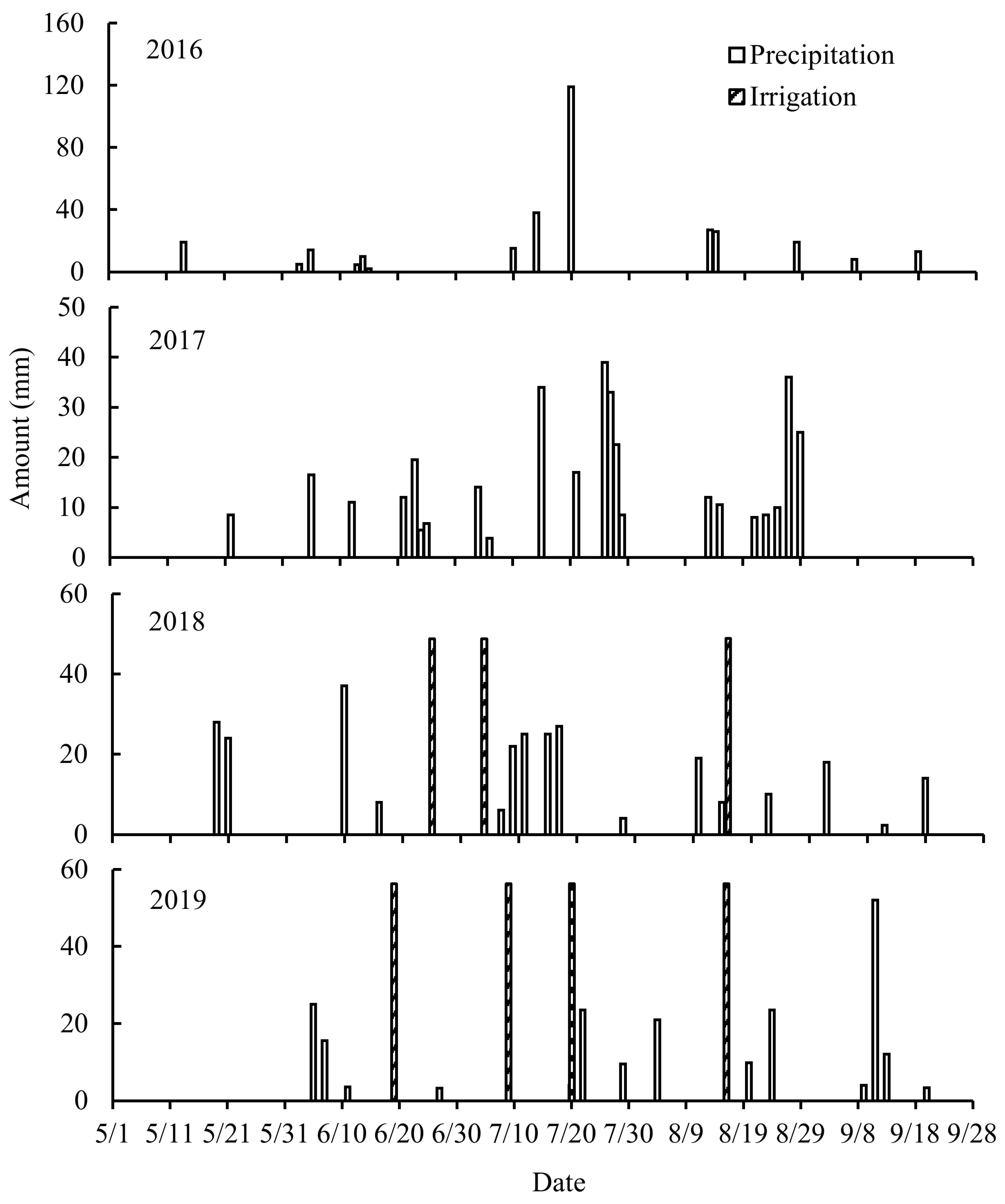
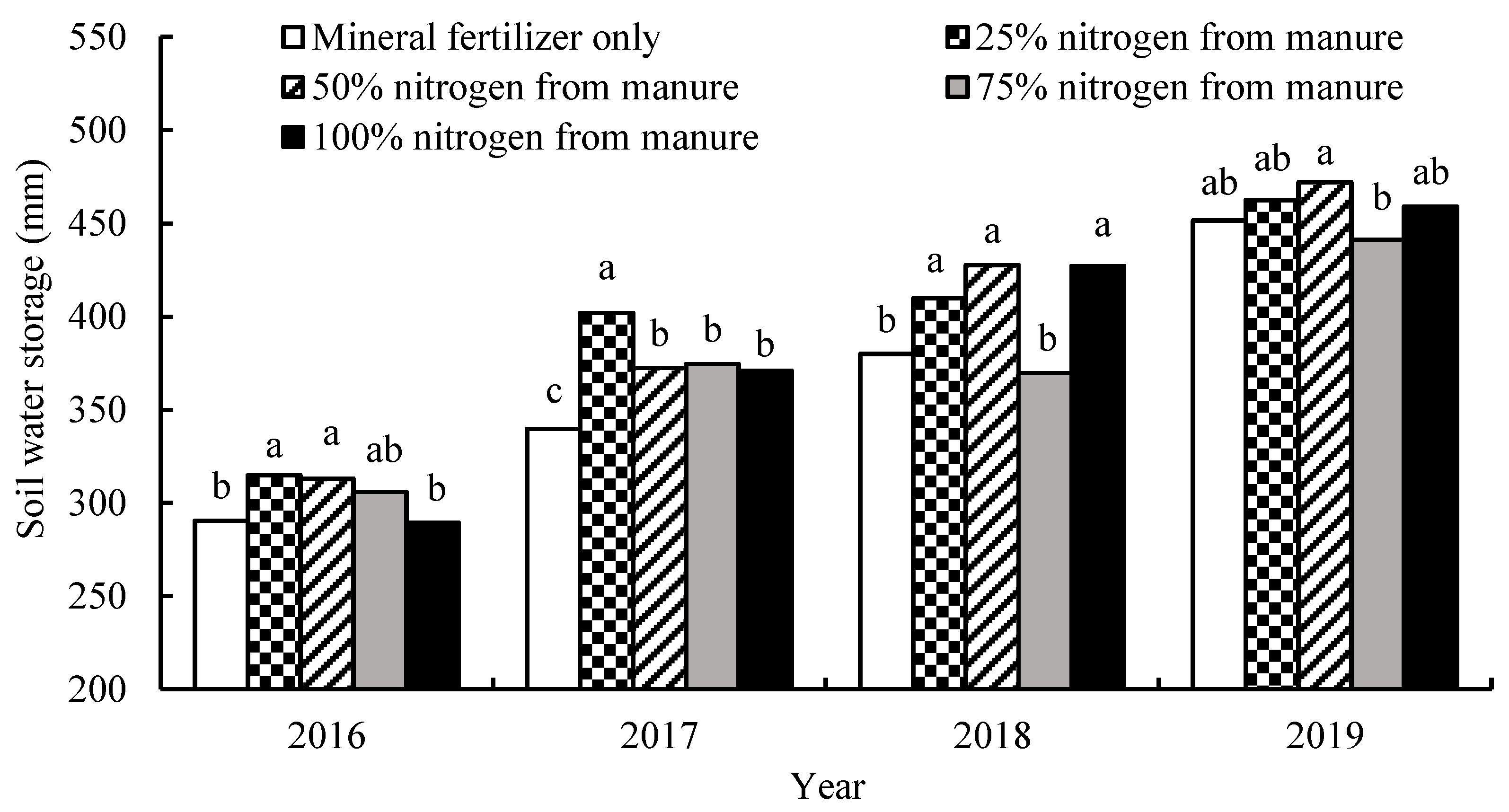
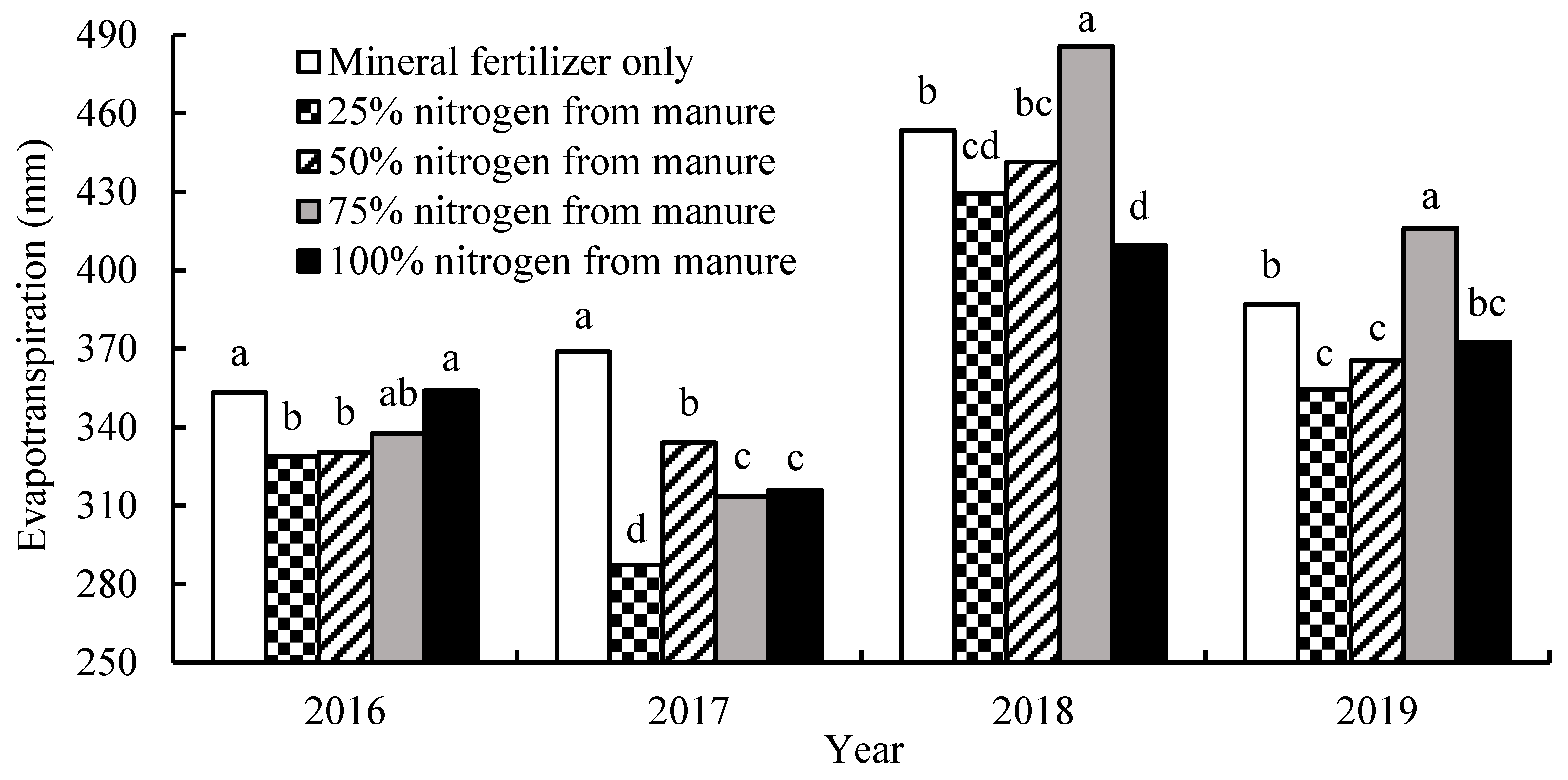
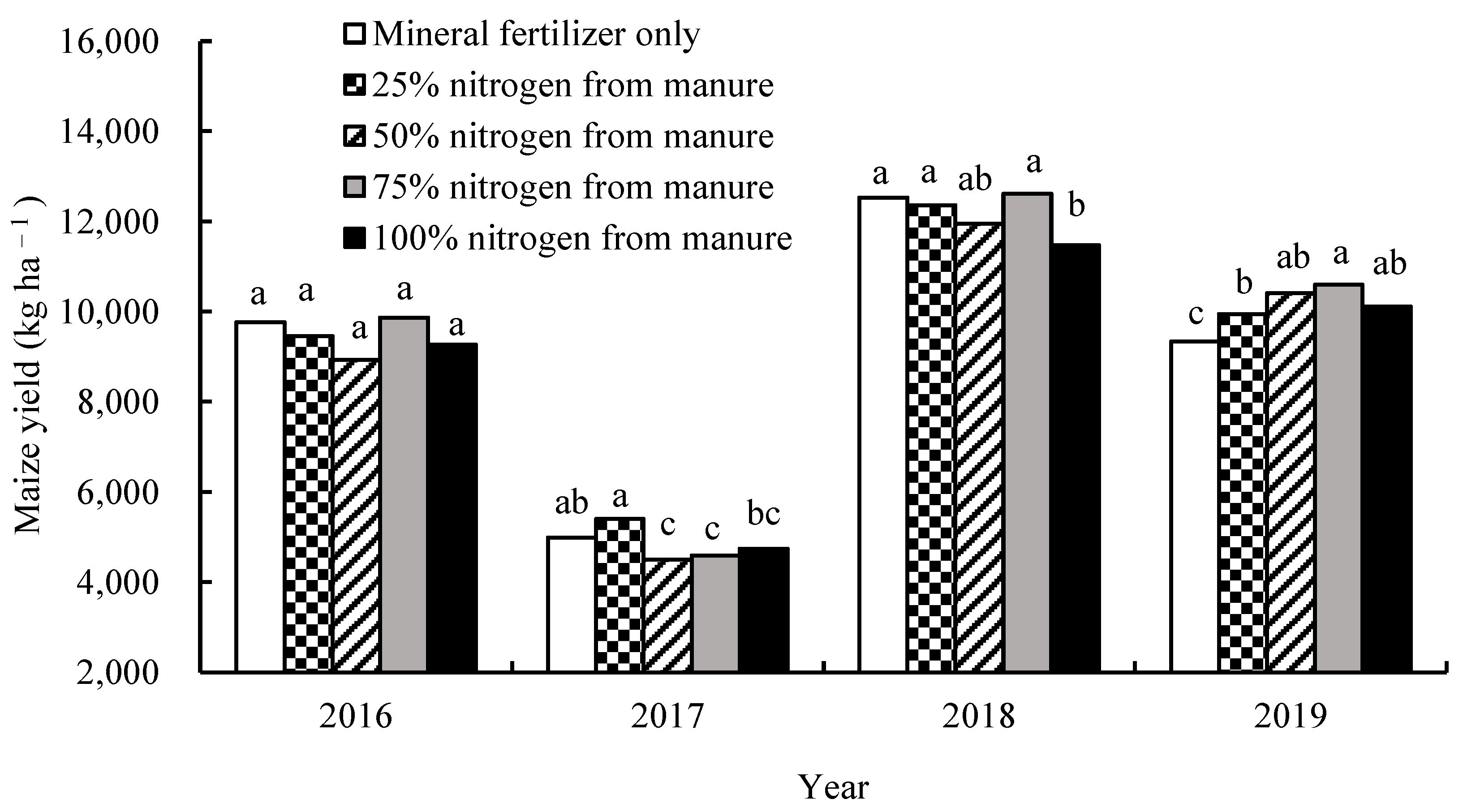


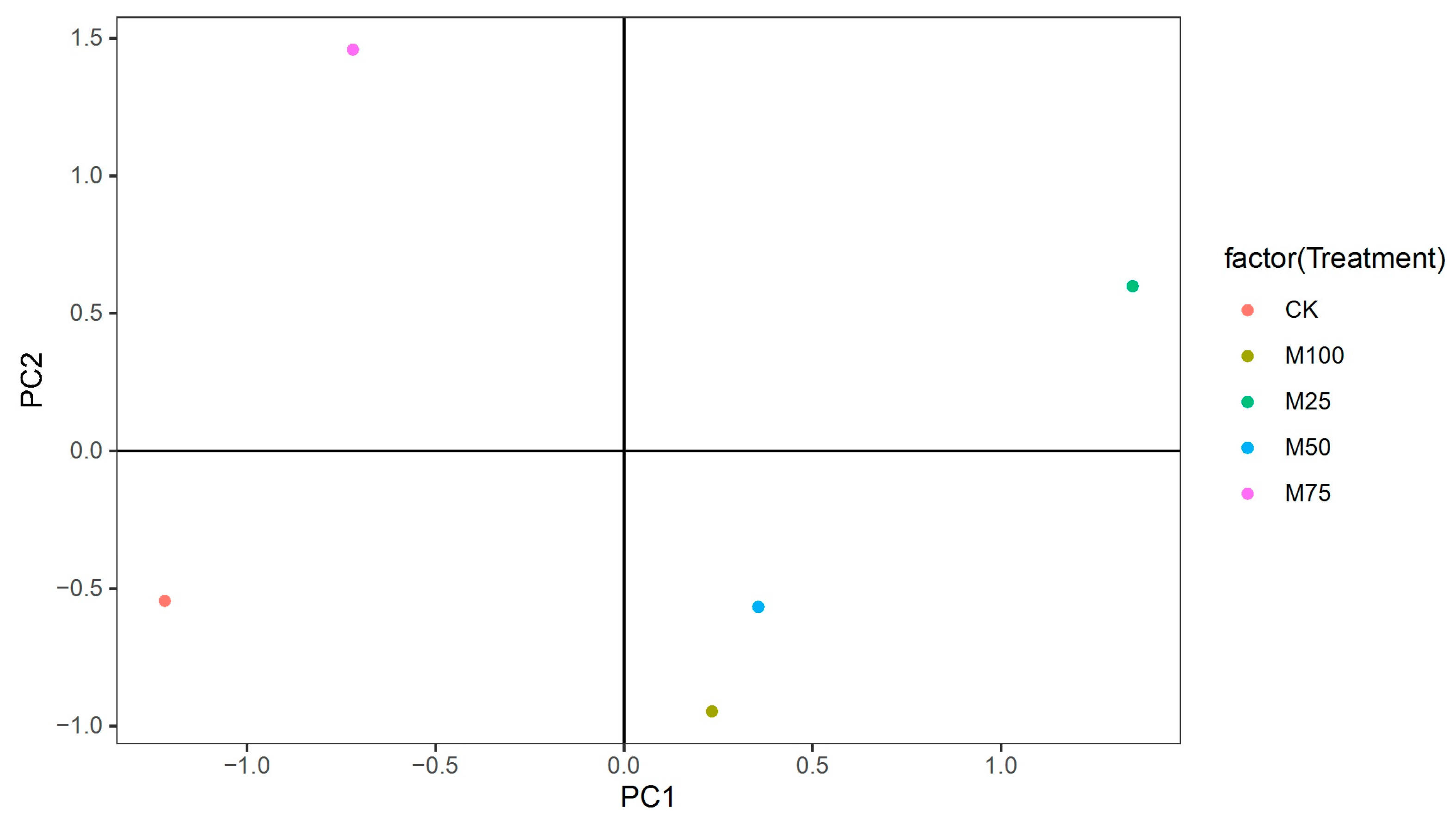
| Treatment | Year | |||
|---|---|---|---|---|
| 2016 | 2017 | 2018 | 2019 | |
| CK | 0 | 0 | 0 | 0 |
| M25 | 2.50 | 2.63 | 2.75 | 2.35 |
| M50 | 5.01 | 5.27 | 5.51 | 4.69 |
| M75 | 7.51 | 7.90 | 8.26 | 7.04 |
| M100 | 10.01 | 10.53 | 11.01 | 9.39 |
Disclaimer/Publisher’s Note: The statements, opinions and data contained in all publications are solely those of the individual author(s) and contributor(s) and not of MDPI and/or the editor(s). MDPI and/or the editor(s) disclaim responsibility for any injury to people or property resulting from any ideas, methods, instructions or products referred to in the content. |
© 2023 by the authors. Licensee MDPI, Basel, Switzerland. This article is an open access article distributed under the terms and conditions of the Creative Commons Attribution (CC BY) license (https://creativecommons.org/licenses/by/4.0/).
Share and Cite
Wang, X.; Tian, L.; Xu, L. Effects of Manure-Based Nitrogen Substitution for Chemical Nitrogen Fertilizers on Economic Benefits and Water-Use Efficiency of Maize. Agronomy 2023, 13, 3031. https://doi.org/10.3390/agronomy13123031
Wang X, Tian L, Xu L. Effects of Manure-Based Nitrogen Substitution for Chemical Nitrogen Fertilizers on Economic Benefits and Water-Use Efficiency of Maize. Agronomy. 2023; 13(12):3031. https://doi.org/10.3390/agronomy13123031
Chicago/Turabian StyleWang, Xiaojuan, Le Tian, and Lulu Xu. 2023. "Effects of Manure-Based Nitrogen Substitution for Chemical Nitrogen Fertilizers on Economic Benefits and Water-Use Efficiency of Maize" Agronomy 13, no. 12: 3031. https://doi.org/10.3390/agronomy13123031
APA StyleWang, X., Tian, L., & Xu, L. (2023). Effects of Manure-Based Nitrogen Substitution for Chemical Nitrogen Fertilizers on Economic Benefits and Water-Use Efficiency of Maize. Agronomy, 13(12), 3031. https://doi.org/10.3390/agronomy13123031





